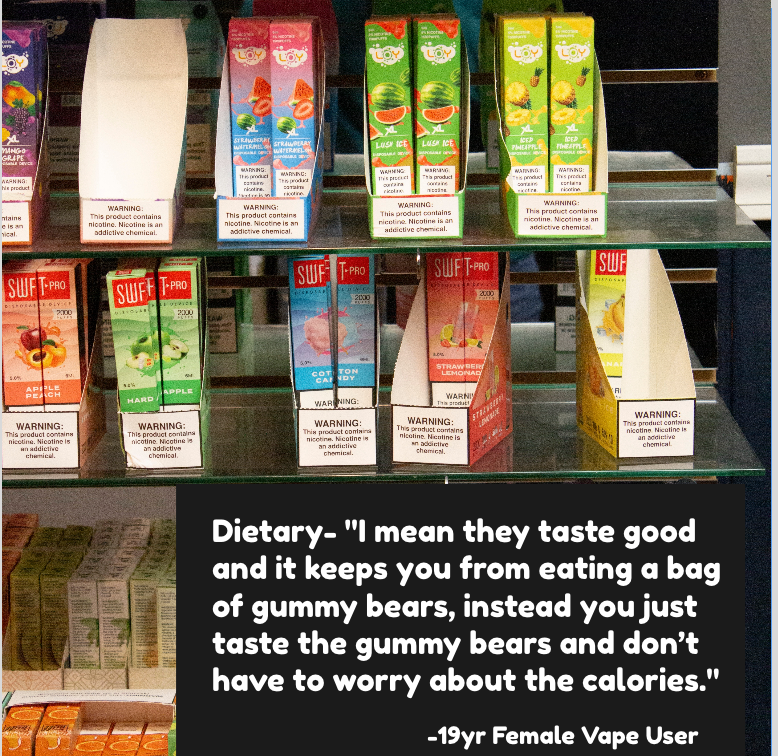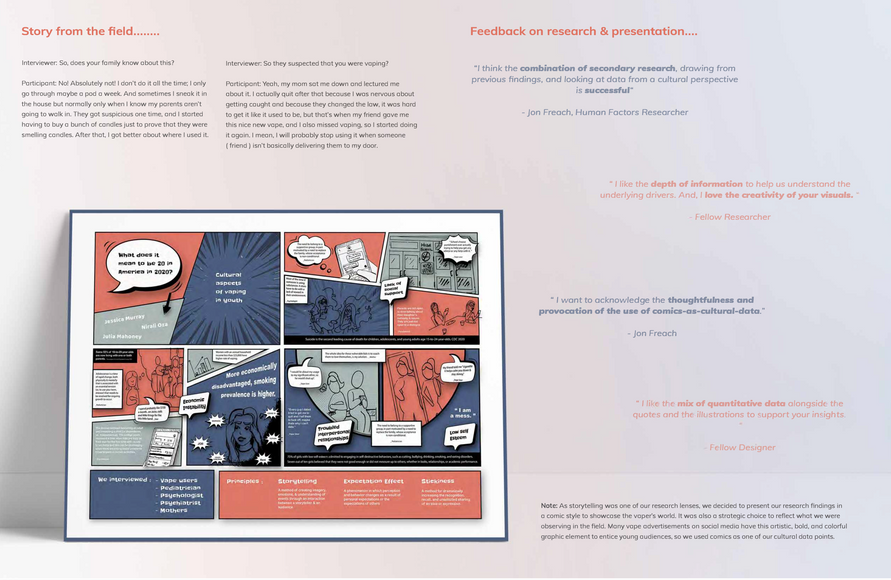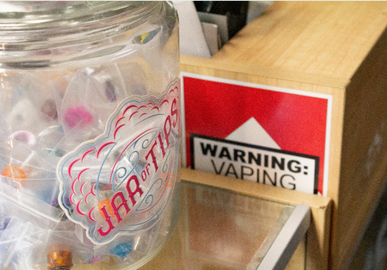


Uncovering the root causes of vape addiction through design research.
# Girl don't Vape
PROJECT BACKGROUND:
*This project captures female vape users' perceptions, beliefs, and behavior around vaping through a seven week long design research project reporting physical, social, cultural, and cognitive factors influencing vape addiction.
Vape users come from diverse backgrounds, but recent trends show a growing focus on younger users, especially females, this is due to :
Perception vs Reality
Many perceive vaping as a healthier alternative to smoking
This perception often blinds users to their own addiction and hinders the development of healthy stress-coping mechanism
Female usage Statistics
A 2018 Statistic survey revealed that 60% of females had tried vaping or e-cigarettes.
This raises concerns about both short- and long-term health impacts.
Data Gaps:
While quantitative reports on youth vape addiction are abundant,
they often lack qualitative insights.
There is little understanding of why young people,
especially young women, choose to vape.
Research Focus
Early findings in our research highlighted this gap.
We decided to focus on young Caucasian females (ages 17–28) who vape.
01. THE CHALLENGE:
How might we best utilize various design research
methods to uncover the root causes of vape addiction
in young (age 17-28 years) females?
03. THE OUTCOME:
-
We had 7 deliverables.
-
Social ecosystem map
-
Vape user archetypes
-
4 Research posters
02. THE APPROACH:
To develop a holistic understanding of a young
female, vaper's world and the "WHY"
behind her vape addiction.
We recruited, seven caucasian
females between ages 17 to 28
Qualitative design research methods :
-
Contextual inquiry
-
Interviews
-
Digital ethnography
-
Co-creation of the social ecosystem
Subject Matter Experts :
-
Respiratory Specialist
-
FDA Health Scientist
-
Physician
-
Vape shop manager
-
Goals
-
Keep our design research grounded in facts
-
Validate / refine our insights and
-
assumptions as needed.
The research posters incorporated pictures, stories,
quotes, and observational insights from the
contextual inquiries and other design research
activities divided into a framework that captured
physical, social, cultural, and cognitive aspects of vaping.
Through various design research methods, we
managed to gather rich data and personal insights
into girls' behavior towards vaping.
We synthesized and analyzed this data to generate
fifteen themes, four insights, six design criteria,
and four "How might we statements,"
providing a roadmap for possible solutions.
THREE (3)
ROLE:
Design researcher/Service Designer
TEAM SIZE:
MY CONTRIBUTIONS:
-
Drafted the research blueprint, research plan,
prototyping, and contribution to the final deliverables.
-
Led SME interviews with a Pulmonologist, Respiratory therapist,
and a Vape shop owner.
-
Contributed to the social ecosystem map
-
Collaborated with the team in planning, primary and secondary research,
field visits, and contextual inquiry.
-
Delivered the remote contextual theory/
research methodology visual.
-
Synthesized raw data and contributed to graphics.

I LIKE THE MULTIPLE DIMENSIONS OF PHYSICALITY THAT YOU EXPLORED, DOCUMENTED, AND STUDIED. YOUR OBSERVATIONS ARE STRONG NARRATIVES. YOUR PHOTOS, VIDEOS, AND SOCIAL MEDIA EXAMPLES CONVEY THE TEXTURE OF THE STUFF OF VAPING. THE COLLECTIVE FIELD NOTES LEAVE ME A LITTLE SHOCKED - EXACTLY WHAT YOU SHOULD STRIVE FOR.“
-Jon Freach, Senior design researcher and field research professor
Research Report Posters
If you want to learn more about the research, read the full case study below
01.
THE CHALLENGE:
How might we best utilize various design research methods to
uncover the root causes of vape addiction
in young (age 17-28 years) females?




WHY FEMALE?
Percentage of adults in the U.s. who tried vaping or using E-cigs as of 2018.


"I STARTED VAPING WHEN I WAS 16.MOST OF MY FRIENDS DO; IT WASN'T A BIG DEAL. IT'S NOT LIKE THE GOOD KIDS DON'T VAPE AND THE BAD KIDS DO; EVERYONE DOES."
-18 y/o Female Vape user.
02.
THE APPROACH:
We divided our design research efforts into four major areas of investigation: Physical, Social, Cultural, and Cognitive vape
addiction influencers—the snapshot of the research scope, questions, activities, and deliverables captured in the research
blueprint.
We used entry point and color design principles to investigate physical aspects of vaping that influence the users' vape behaviors, such as the design of the device, fashion, accessories, and physical spaces where vapers hang out and vape. We began with conducting contextual inquiries at a local cosmetic college and at a vape shop where we interacted with vape users. We recruited young caucasian female vapers (ages 17 to 28) for semistructured interviews. We also interviewed the vape shop manager, who helped us understand the different devices, juices, marketing tactics, purchasing trends, and vape jargon.
We used entry point and accessibility design principles to better understand vape users' social behavior. We focused on the accessibility of vape devices and their impacts on the vaping epidemic in the USA. We also co-designed the social ecosystem of users to identify the elements in vape users' social environments that promote vape use. We interviewed mothers and friends of vapers as well as examined the role of teachers and school administrators in battling the vaping epidemic.
To dive deep into the cultural aspects of vaping and feel young vape users' emotions and assumptions, we asked, "What does it mean to be a 20-year-old vaper in the U.S.? We looked at it through the lens of two research principles: Stories and Stickiness. We conducted digital ethnography by signing up for various virtual vape communities, participating in online discourse, and following hashtags in order to generate empathy for our young vapers and see the issue from their perspective. We used comic-as-cultural data to showcase our field notes and research insights.
Finally, to investigate the cognitive aspects of vaping, we revisited our interview notes and recordings. We synthesized and analyzed our data to dive deeper beyond the surface level of understanding of 'WHY.' In this research area, we explored psychological topics such as oral fixation and defense mechanisms - denial, rationalizations, and intellectualization. We consulted a psychiatrist to understand addiction psychology and patterns of addictive behaviors. We converted these learning and insights into three behavioral archetypes of vape users.
Social:
Physical:
Cultural:
Cognitive:
Research Blue Print:

Research blueprint- The snapshot of research scope, activities and deliverables.
Vape shop Window
It really is a physical representation of the body. It may not be nicotine,
it may not be tar, but it is juicy gross oil that is hard to get off."
- Vape user.
*Our user led us to to a window containing vape juice deposits and build up.
Contextual Inquiry:


"I VAPE BECAUSE IT KEEPS ME FROM LOSING MY MIND AND FEELING LIKE GARBAGE."
-16 y/o female vape user.
03.
THE OUTCOME:
We started to see common patterns in our data through thematic analysis and affinity diagramming, which led us to identify themes. From the data gathered in our interviews with community members, we developed a social ecosystem map to understand the vaper's world better. We also used the framework of the behavioral archetype to showcase various types of vape users accurately. Our final insights report included key themes, insights, design criteria, and how we might statements to turn our Insights into opportunities.
Insights
01.
#hashtags,fashion, and addciton
With more and more marketing tactics concentrating on social media, vaping has gained access to a younger generation. With social influencers exhibiting vape tricks and showcasing various devices and accessories, vaping is a new status symbol for a younger generation. The vaping industry has focused on creating products that give the user a fashion statement, from the device itself to the accessories and extraneous fashion items that provide the user the feel of being a part of a like-minded group.
02.
The vaping ecosystem created a sense of belonging
Vaping is a piece of a broader social ecosystem. It is a way for many young people to identify themselves as a part of a particular tribe. This is an industry that relies heavily on word of mouth, social media recommendations, and fashionable trends. In fact, many first-time users experience vaping from a friend's device.
03.
It’s not THAT bad for you.....
Perception of Safety !
Since vaping is a healthier alternative to the chemicals inhaled by cigarette smokers, it has gained the reputation among the vaping community as a safer option. For young females, there is also a perception that there are fewer reproductive consequences to using these devices simply because of a lack of current research on the topic.
04.
Parents want to help
but don't know how?
We learned that young girls have a hard time discussing their addiction issues with their parents. For them, hiding their vaping habits from their parents is a way to assert their independence. These conversations then become less about understanding the underlying causes and more about the actual vaping behavior and take place on the parents' terms.
Social Ecosystem Map
We co-created a social ecosystem of vapers capturing data about vapers' most essential influencers, essential relationships, interactions, and exchanges. We asked a series of questions to vapers regarding trust, contact, and interaction between vapers and their social circle. We conducted digital ethnography by signing up for various virtual vape communities, participating in online discourse, and following hashtags in order to generate empathy for our young vapers. We interviewed three vapers, co-created the ecosystem like what you see on the Ecosystem Activity visual., and combined the three ecosystems to create the final graphic below.


Ecosystem mapping
Using insights from our ecosystem activity, we made our own ecosystem map to fully understand how the systems are all interconnected.

"I LIKE THAT YOU TRIED DIGITAL ETHNOGRAPHY - A DIGITAL IMMERSION; IT FELT LIKE YOU TOOK US TO THE VAPING WORLD; THE ECOSYSTEM IS RICH AND REVEALING THE COMPLICATED, CONFLICTING, AND COMPETITIVE NATURE OF THIS HABIT. I APPRECIATE THE USE OF AND EXPLICIT NATURE OF YOUR PRINCIPLES; YOU CAN SEE/FEEL THEM IN YOUR ECOSYSTEM."-
Jon Freach, Senior design researcher and field research professor
Comic-as-cultural data
For cultural data, we wanted to highlight and generate empathy for issues such as lack of social support, economic instability, low self-esteem, and troubled interpersonal relationships that young females face that further exacerbate additive and self-harm activities. As storytelling was one of our research lenses, we decided to present our research findings in a comic style to showcase the vaper’s world. It was also a strategic choice to reflect what we were observing in the field. Many vape advertisements on social media have this artistic, bold, and colorful graphic element to entice young audiences, so we used comics as one of our cultural data points.


"I WANT TO ACKNOWLEDGE THE THOUGHTFULNESS AND PROVOCATION OF THE USE OF COMICS-AS-CULTURAL-DATA. I LIKE THE DEPTH OF INFORMATION TO HELP US UNDERSTAND THE UNDERLYING DRIVERS. AND, I APPRECIATE THE MIX OF QUANTITATIVE DATA ALONGSIDE THE QUOTES AND THE ILLUSTRATIONS TO SUPPORT YOUR INSIGHTS.
"- Jon Freach, Senior design researcher and field research professor
Archetypes
We consulted a psychiatrist to understand addiction psychology and patterns of addictive behaviors and converted our insights and learning into three behavioral archetypes representing typical users' motivations, beliefs, and general attitudes towards vape addiction.

Next steps
In order to thoughtfully summarize our research insights and build actionable steps for the designers to frame the proper challenge, we decided to create a one-pager that includes central themes which feed into design insights, design criteria, and How Might We (HMW) statements.
"How Might We" (HMW) statements are small but mighty questions that allow us to reframe our insights into opportunity areas and innovate on problems found during user research. They are a rewording of the core need, which we uncovered through user research and helped us focus on user needs and problems rather than just jumping straight to solutions. These statements help inspire user-centered design!

04.
TAKEAWAYS
Our retrospective analysis
-
Highlighted key lessons for future iterations: while social media can be a powerful research tool, it also presents distractions that require careful navigation. We learned that whimsical concepts may not always produce reliable results. Most importantly, we emphasized the value of a comprehensive project repository and the necessity of having contingency plans in place. These practices proved essential for efficient and adaptable project management."
-
This project taught me the importance of zooming in and out mindset and techniques to build a holistic understanding of the issue we are investigating. It provided depth and breadth to our research questions and efforts resulting in rich data. Designing a one-page research blueprint was a successful strategic choice from the team ,as it helped the team explore multiple perspectives in a short period without losing focus.
-
Perhaps the most challenging part of the design project was to convert research insights into solutions and make those solutions a reality. It becomes more challenging when different teams are working at the different phases of the project. It is crucial for researchers to think about how to communicate and present research data strategically and efficiently so that it helps designers digest and internalize the insights to create meaningful solutions.
Zoom in and out :
Communication and Presentation:

THE TEAM DID A GREAT JOB OF EXPLORING THE SOCIAL, CULTURAL, COGNITIVE, AND PRACTICAL ASPECTS OF ADDICTION TO VAPING. THEIR APPROACH TO USER RESEARCH WAS ORIGINAL AND INFORMED BY THE VERY CULTURE THEY SET UP TO STUDY. THEY USED SECONDARY RESEARCH, CONTEXTUAL INTERVIEWS, COMICS, AND EVEN FACTORED IN THE CULTURE OF VAPING TO GATHER MEANINGFUL INSIGHTS FROM USERS."
- José Colucci, Director of Research & Development at the Design Institute for Health
"Tell me about a time that you failed..."
-
Our efficacy was hindered by the narrow timeframe of only 7 brief weeks, which limited us to effectively address the emerging addiction phenomena inherent in these novel vaping devices and inhalants.
-
Moreover, in light of the novel stressors confronting younger generations, which they have yet to develop coping mechanisms for, there is an urgent need for innovative strategies to engage a demographic deeply entrenched in social media and marketing influences. It is imperative that we reassess our reliance on abstinence-only education and scare tactics; instead, we must recognize that individuals turn to coping mechanisms when confronted with adversity. Hence, there is a pressing need to identify healthier, more person-centric approaches to intervention.
Photography from the field


.png)
.png)

.png)

.png)

.png)

Fun fact:
This is a particularly unique design challenge, because, back In 2013 James Monsees the co-founder of the vaping brand JUUL gave a TED talk about the success of his company saying, “We were taught a concept called design thinking. And design thinking is purely just empathy. You try to understand a person's needs. And then you test and see if you got it right by creating prototypes.” Vaping is a trend that has taken off because it has been designed to do that very thing. So if design thinking got us into this mess, we wondered if it could get us out.


"A few years ago, I had the privilege of being a fellow at a place called the d.School on Stanford's campus. We did something very simple there. We were taught a concept called design thinking. And design thinking is just purely empathy. You try to understand a person's needs, and then you test and see of you got ir right by creating prototypes."














